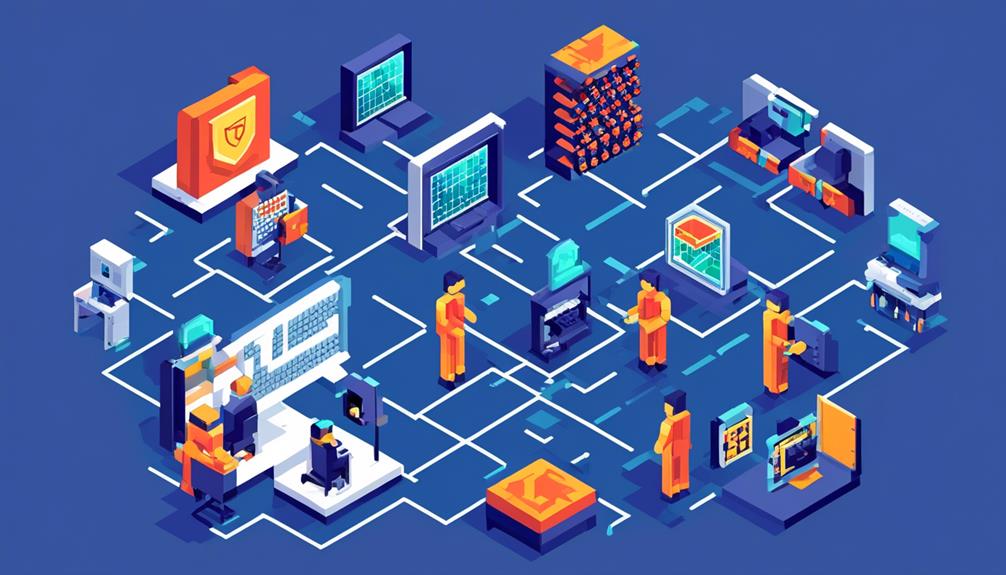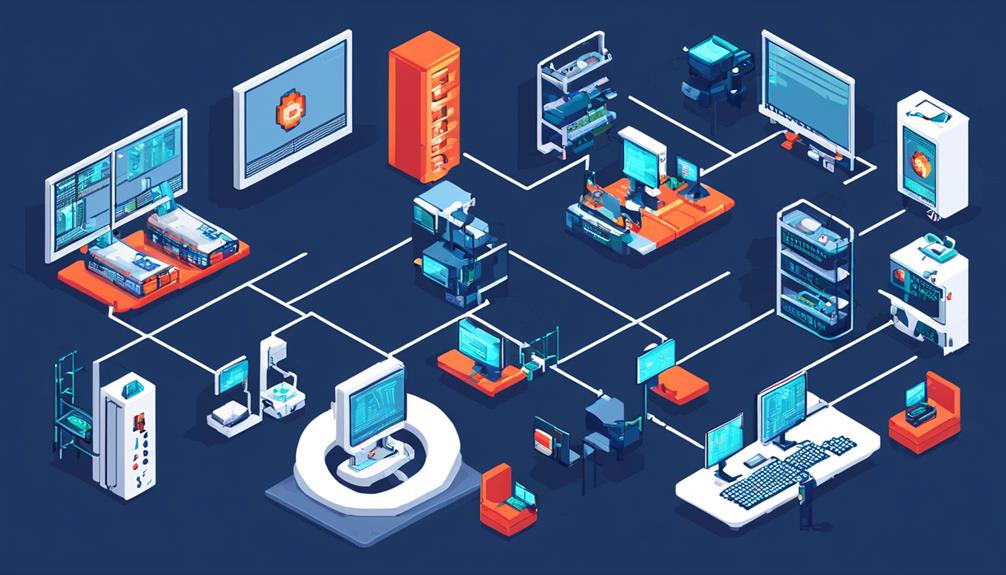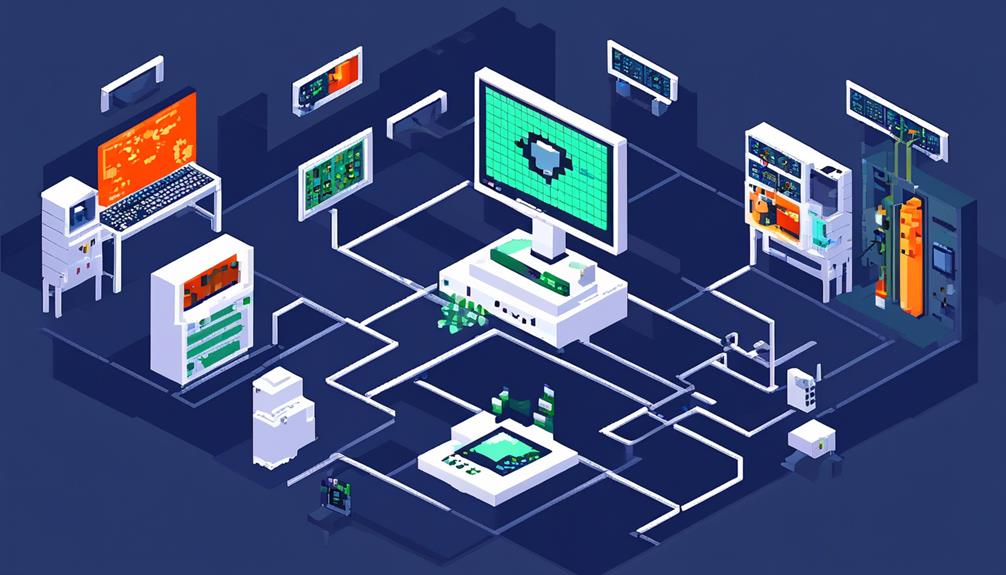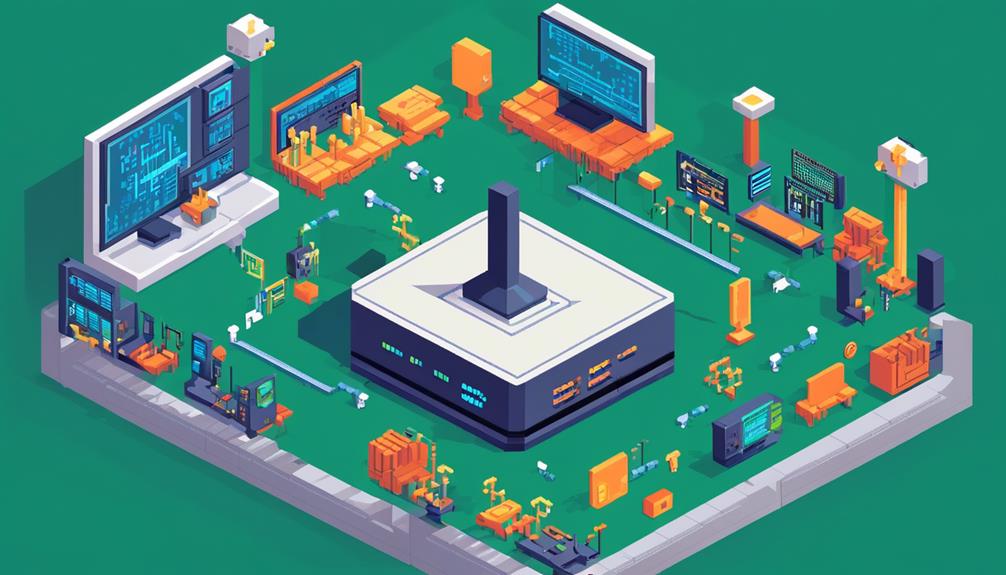Network security is a critical aspect of any organization's information technology infrastructure. With the ever-increasing threat landscape, it is imperative to have a robust network security hardware in place.
The fundamentals of network security hardware encompass a wide range of devices and tools that work together to protect the network from unauthorized access and malicious activities. From firewalls and intrusion detection systems to virtual private networks and secure web gateways, these hardware components play a vital role in ensuring the confidentiality, integrity, and availability of network resources and data.
In this discussion, we will explore the essentials of network security hardware, delving into the different types of devices and their functionalities. By understanding these fundamentals, organizations can fortify their network defenses and mitigate potential security risks.
So, let's dive into the world of network security hardware and uncover the key components that form its foundation.
Key Takeaways
- Firewall Basics: Firewalls are essential network security components that act as a barrier between internal and external networks, monitoring and controlling incoming and outgoing traffic based on predefined security policies.
- Intrusion Detection Systems (IDS) and Intrusion Prevention Systems (IPS): IDS and IPS are network security technologies that help detect and prevent unauthorized access, malicious activities, and potential security breaches by analyzing network traffic and patterns.
- Virtual Private Networks (VPNs): VPNs provide secure and encrypted connections over public networks, allowing remote users to access private networks securely. They ensure confidentiality, integrity, and authentication of data transmitted between the user and the network.
- Network Segmentation: Network segmentation involves dividing a network into smaller subnetworks or segments to minimize the impact of a security breach. It helps in isolating sensitive data and limiting lateral movement of threats, improving overall network security.
Firewall Basics

Firewall Basics encompass the foundational principles and functionalities of network security hardware that act as a barrier between internal network traffic and the external internet, enforcing segmentation strategies and limiting east-west traffic to minimize attacker movement. Firewalls are a fundamental component of most security setups, providing a baseline of security for networks by blocking connections based on specific criteria.
Dedicated hardware firewalls are preferred due to their ability to handle larger volumes of traffic and better vendor support. These firewalls are configured to deny incoming traffic by default, ensuring that only authorized traffic is allowed into the network. By creating zones of trust, firewalls separate internal networks from the internet, preventing unauthorized access and protecting network resources.
Firewalls are capable of blocking specific types of traffic based on pre-configured rules. These rules can be defined to restrict access to certain ports or protocols, preventing potential threats from entering the network. Additionally, firewalls can be configured to inspect network traffic for malicious content, such as viruses or malware, and prevent it from reaching its intended destination.
Network security hardware, such as firewalls, play a crucial role in preventing unauthorized access and data breaches. They act as a first line of defense, filtering incoming and outgoing traffic to ensure that only legitimate traffic is allowed. By enforcing segmentation strategies and limiting east-west traffic, firewalls minimize the potential for attackers to move laterally within a network, reducing the overall risk to an organization's assets.
Intrusion Detection Systems (IDS)
Intrusion Detection Systems (IDS) play a crucial role in network security by monitoring network traffic for suspicious activity or policy violations. They can detect unauthorized access, malware, or denial of service attacks, providing real-time alerts to potential threats.
When deploying IDS, organizations need to consider factors such as network topology, traffic volume, and system compatibility to ensure effective and accurate detection of intrusions.
IDS Functionality Overview
An integral component of network security infrastructure, the functionality of Intrusion Detection Systems (IDS) encompasses vigilant monitoring and detection of unusual or malicious activity within network traffic. IDS serve as a crucial defense mechanism against potential security breaches, providing real-time identification and response capabilities.
The following are key aspects of IDS functionality:
- Monitoring: IDS continuously analyze network traffic, inspecting packets and looking for any signs of suspicious behavior or known attack patterns.
- Detection: IDS can employ signature-based detection, where they compare network traffic against a database of known attack signatures. They can also use behavior-based detection, which identifies anomalies by analyzing deviations from normal traffic behavior.
- Response: When an anomaly is detected, IDS can take various actions, such as alerting administrators, generating logs, or blocking the source of the suspicious activity.
- Network vs. Host-based: IDS can be implemented at the network level, monitoring all network traffic, or at the host level, focusing on individual devices and their activity.
Intrusion detection is a critical component of network security, providing organizations with the ability to proactively identify and mitigate potential threats.
IDS Deployment Considerations
When considering the deployment of Intrusion Detection Systems (IDS), careful consideration must be given to the placement within the network architecture in order to effectively cover critical access points and vulnerable areas. Understanding network traffic patterns and user behavior is essential for effective IDS deployment.
IDS should be strategically placed to monitor incoming and outgoing traffic, including network devices such as load balancers, firewalls, and virtual private networks (VPNs). By analyzing network traffic, IDS can detect anomalies and suspicious activity that could indicate an intrusion attempt.
IDS integration with other security tools, such as intrusion prevention systems (IPS) and security information and event management (SIEM), enhances the overall security posture. Regular updates and maintenance of IDS signatures and rules are necessary to effectively detect and prevent threats.
Intrusion Prevention Systems (IPS)

Intrusion Prevention Systems (IPS) play a crucial role in network security by monitoring network traffic and preventing intrusions. They utilize various techniques such as pre-made profiles, signature detection, AI, and anomaly detection to detect and mitigate different types of attacks.
IPS systems can inspect packets, match signatures, and communicate with other network hardware in real time, making them an essential component of a comprehensive network security strategy.
IPS Functionality
IPS functionality is a critical component of network security, actively monitoring network traffic for potential intrusions and suspicious activity. To accomplish this, IPS tools use various techniques such as packet inspection, signature matching, and anomaly detection.
Here are four key features of IPS functionality:
- Real-time communication: IPS systems can communicate with other network hardware in real time, allowing them to request firewall quarantining and protect against different types of attacks.
- Malware detection: IPS systems have the capability to detect malware on endpoint devices. Upon detection, they can quarantine and remove threats, preventing further damage.
- Preemptive security measures: IPS functionality plays a crucial role in preemptive security measures by actively monitoring network traffic and blocking potential attacks before they can cause harm.
- Enhanced network security: By actively monitoring network traffic and identifying potential threats, IPS functionality enhances overall network security by providing an additional layer of protection.
IPS Deployment
With the foundation of IPS functionality established, the focus now shifts to the practical implementation of IPS deployment within a network architecture.
IPS deployment involves strategically placing intrusion prevention systems within the network to monitor and prevent malicious activities. These systems utilize packet inspection and signature matching techniques to identify and prevent potential attacks.
By actively monitoring network traffic for threats, deploying IPS allows for a proactive security approach. Furthermore, IPS systems can communicate with other network hardware in real time, enabling swift response to detected intrusions.
This real-time communication ensures that potential threats are addressed promptly, minimizing the risk of damage or data breaches.
Virtual Private Networks (VPNs)
Virtual Private Networks (VPNs) are secure and encrypted connections that allow remote users to access private networks. They provide a way for individuals or organizations to establish a secure connection over public networks, such as the internet.
Here are four key facts about VPNs:
- Secure and encrypted connections: VPNs use encryption protocols to ensure that data transmitted between the user and the private network remains secure. This prevents unauthorized access and protects sensitive information from being intercepted.
- Remote access to private networks: VPNs enable remote users to connect to private networks as if they were physically present in the same location. This is particularly useful for employees working remotely or traveling, as they can securely access company resources and work as if they were in the office.
- Masking user location: By connecting through a VPN server, users can hide their actual location and appear as if they are accessing the internet from a different location. This can be beneficial for bypassing geographic restrictions or maintaining anonymity online.
- Enhanced security for data transmission: VPNs provide an additional layer of security for transmitting sensitive data over public networks. By encrypting the data, VPNs protect it from being intercepted or tampered with during transmission, ensuring the integrity and confidentiality of the information.
Network Access Control (NAC)

Network Access Control (NAC) is a crucial security solution that regulates and manages access to network resources based on policies and user identity, building upon the secure and encrypted connections provided by Virtual Private Networks (VPNs). NAC performs identification, authentication, and authorization of devices and users seeking to connect to the network. By enforcing security policies, NAC ensures that only compliant and authorized devices and users can access the network, reducing the risk of unauthorized access and potential security threats.
NAC solutions go beyond traditional access control mechanisms by providing real-time monitoring and control of endpoint devices. They can scan devices for security vulnerabilities, ensure compliance with security policies, and remediate non-compliant devices before granting network access. This proactive approach helps organizations maintain a secure network environment.
Furthermore, NAC can integrate with other security technologies such as firewalls, intrusion detection systems, and antivirus software to enhance overall network security. It allows for centralized management and visibility, enabling administrators to have a comprehensive view of network access and enforce consistent security policies across the organization.
NAC also plays a crucial role in preventing unauthorized access from compromised or malicious devices. By continuously monitoring devices and users, NAC can detect and respond to suspicious behavior, such as unauthorized access attempts or abnormal network activity. This proactive security measure helps organizations identify and mitigate potential threats before they can cause significant damage.
Secure Socket Layer (SSL) Certificates
Secure Socket Layer (SSL) certificates play a crucial role in ensuring the privacy, integrity, and authentication of data transmitted between web browsers and servers.
Here are four important facts about SSL certificates:
- Secure Communication: SSL certificates provide secure, encrypted communication between a web browser and a web server. This encryption ensures that sensitive information transmitted over the internet, such as credit card numbers and personal details, cannot be intercepted or accessed by unauthorized individuals.
- Privacy and Integrity: By encrypting data, SSL certificates ensure that the information remains private and integral during transmission. This prevents any unauthorized modification or tampering of the data, maintaining its integrity and protecting it from being compromised.
- Trust and Confidence: Websites using SSL certificates display a padlock icon in the address bar, assuring visitors that the connection is secure. This visual indicator builds trust and confidence among users, encouraging them to share sensitive information and engage in secure online transactions.
- Authentication: SSL certificates also authenticate the identity of the website. They verify that the website being accessed is genuine and belongs to the organization it claims to represent. This authentication process helps protect users from phishing attacks and ensures that they are interacting with legitimate websites.
Data Loss Prevention (DLP)

Data Loss Prevention (DLP) technology serves as a crucial safeguard against unauthorized data exfiltration or leakage, complementing the security provided by SSL certificates. DLP tools are designed to monitor, detect, and prevent the unauthorized movement of sensitive data. These tools can inspect and control data in use, data in motion, and data at rest across the network.
DLP solutions utilize policies to identify and protect sensitive data, such as personally identifiable information or intellectual property. By monitoring network traffic and data transfers, DLP technology can identify and block any attempts to transmit sensitive information outside the organization's network. This proactive approach helps organizations prevent data breaches and comply with industry regulations.
DLP technology can be deployed through various means, including hardware appliances, software, or cloud-based solutions. Hardware appliances offer dedicated processing power and can handle large network volumes effectively. Software-based solutions provide flexibility and scalability, allowing organizations to customize their DLP policies and adapt to changing security needs. Cloud-based DLP solutions offer ease of deployment and management, making them an attractive option for organizations with limited IT resources.
Network Segmentation
Network segmentation offers several benefits in terms of security.
These benefits include the ability to control data flow between networks, improve network performance, and limit the impact of potential security breaches.
When implementing network segmentation, organizations need to consider factors such as the use of VLANs or virtual private clouds (VPCs), configuring routers, and understanding business requirements.
Benefits of Segmentation
Segmentation plays a crucial role in enhancing network security by effectively controlling and isolating the flow of data between different network segments. Here are the benefits of segmentation:
- Reduces the attack surface: By dividing the network into smaller segments, the potential attack surface is minimized. This limits the ability of attackers to move laterally within the network, making it more difficult for them to gain unauthorized access to sensitive data or systems.
- Contains security breaches: In the event of a security breach or incident, network segmentation allows organizations to contain and mitigate the impact. By isolating affected segments, the spread of malware or unauthorized access can be limited, preventing further damage.
- Enables tailored security policies: With network segmentation, organizations can prioritize and enforce different security policies based on the needs and sensitivity of each segment. This ensures that appropriate security measures are applied where they are most needed, enhancing overall protection.
- Optimizes performance and management: Segmentation allows for better network performance and management by optimizing traffic flow and prioritizing critical applications. This helps ensure that resources are allocated efficiently and that network performance is not compromised.
Implementation Considerations
One crucial factor to consider when implementing network segmentation is configuring and controlling access to VLANs and VPCs based on the organization's specific business requirements. VLANs, or Virtual Local Area Networks, are commonly used to segment networks and improve security. Routers play a vital role in enabling traffic between VLANs by forwarding packets based on the configured rules. Another option for network segmentation is the use of Virtual Private Cloud (VPC), which provides isolation and control over network resources in the cloud. When implementing network segmentation, it is important to understand the organization's specific business requirements to ensure that the VLANs and VPCs are configured in a way that meets the organization's security and operational needs.
| Network Segmentation Considerations | Key Points |
|---|---|
| VLANs | – Commonly used for network segmentation <br> – Control data flow between networks |
| Routers | – Enable traffic between VLANs based on configuration |
| VPCs | – Option for network segmentation in the cloud <br> – Provides isolation and control over network resources |
Security Risks Mitigation
To mitigate security risks, implementing network segmentation allows for controlled data flow and separation of network resources. Here are four key points to consider:
- Controlled Data Flow:
Network segmentation enables organizations to control the flow of data between different segments. By dividing the network into smaller segments, security measures can be implemented more effectively, limiting the impact of potential security breaches.
- Resource Separation:
Network segmentation separates network resources, such as servers, workstations, and IoT devices, into different segments. This helps contain the spread of threats and prevents unauthorized access to critical resources.
- VLANs:
Virtual Local Area Networks (VLANs) are commonly used to achieve network segmentation. VLANs allow for the logical separation of network devices, even if physically connected to the same network.
- Router Configurations:
Routers play a crucial role in enabling traffic between segmented networks. Proper configuration of routers is essential to ensure secure communication between segments while enforcing access control policies.
Network Load Balancing
Network Load Balancing is a technique that efficiently distributes incoming network traffic across multiple servers to optimize resource utilization, maximize throughput, and reduce response time. By spreading the workload across several servers, it ensures that no single server is overwhelmed with traffic, enhancing reliability and scalability. Load balancing can be achieved through various algorithms, including round-robin, least connections, and IP hash.
Round-robin algorithm evenly distributes incoming connections to each server in a sequential manner. This approach ensures that each server receives an equal share of the workload. Least connections algorithm, on the other hand, directs new connections to the server with the fewest active connections, ensuring even distribution based on the current load. IP hash algorithm determines the server to which a connection is directed based on the source IP address, achieving session persistence for clients with the same IP.
Implementing network load balancing not only improves the overall performance of the network but also provides a level of fault tolerance. In the event of a server failure, the remaining servers can handle the traffic, minimizing downtime and ensuring continuous service availability. Additionally, load balancing enables horizontal scaling, allowing for the addition of more servers as the network demands increase.
To effectively implement network load balancing, organizations should consider factors such as server capacity, network traffic patterns, and the specific needs of their applications. By adopting this technique, businesses can optimize their network resources, enhance the user experience, and ensure the reliability and scalability of their network infrastructure.
Unified Threat Management (UTM)

After understanding the importance of network load balancing in optimizing resource utilization and ensuring reliability, the next crucial aspect to consider is Unified Threat Management (UTM). UTM is a comprehensive security solution that combines multiple security functions into a single device for simplified management.
Here are four key points to know about UTM:
- Integration of multiple security functions: UTM typically includes features such as network firewall, intrusion detection and prevention, antivirus, content filtering, and VPN capabilities. By integrating these functions into one device, UTM offers convenience and ease of management.
- Cost-effectiveness and efficiency: UTM solutions are particularly beneficial for smaller businesses with limited resources. By consolidating different security tools into a single package, UTM reduces the cost of purchasing and maintaining multiple devices. It also streamlines security management, saving time and effort for IT administrators.
- Potential single point of failure: While UTM offers convenience, it also introduces a potential single point of failure for the entire network. If the UTM device fails, all security functions become unavailable, leaving the network vulnerable to attacks. Therefore, proper redundancy and backup measures should be in place to mitigate this risk.
- Performance and customization considerations: While UTM provides a unified security solution, it may not always match the performance and customization options available with individual security devices. Organizations with specific security requirements or high-performance demands may prefer dedicated devices for each security function.
Secure Web Gateways (SWG)
Secure Web Gateways (SWG) serve as a crucial security control point for organizations, enabling them to enforce internet security policies and effectively inspect web traffic for potential threats. SWGs use a combination of URL filtering, application control, and malware protection to ensure safe web browsing and protect against malicious content. By providing visibility and control over user activities, SWGs help organizations ensure compliance with acceptable use policies and prevent data loss.
One of the key features of SWGs is their ability to decrypt and inspect encrypted web traffic. This provides an additional layer of security against advanced threats and malware that may be hiding within encrypted communications. SWGs achieve this by leveraging SSL/TLS interception techniques, allowing them to inspect the contents of encrypted web traffic without compromising security.
Integration with other security solutions further enhances the effectiveness of SWGs in detecting and preventing web-based threats. By integrating threat intelligence feeds, SWGs can stay up-to-date with the latest threat intelligence and proactively block access to known malicious websites. Additionally, integration with sandboxing solutions allows SWGs to analyze suspicious files and URLs in a controlled environment, providing an extra layer of protection against zero-day threats and emerging malware.
Network Security Appliances

Network security appliances are essential components of a robust network defense strategy. They provide firewall functionality to monitor and control network traffic, ensuring that only authorized connections are allowed.
Additionally, intrusion detection systems help identify and mitigate potential threats in real-time, while VPN capabilities enable secure remote access to the network.
These appliances play a critical role in safeguarding sensitive information and maintaining the integrity and availability of network resources.
Firewall Functionality
Firewall functionality plays a vital role in network security, acting as a barrier between internal networks and the internet to control traffic flow and enforce segmentation strategies.
Here are four important aspects of firewall functionality:
- Traffic control: Firewalls limit east-west traffic within the network perimeter, minimizing attacker movement and enforcing segmentation. This helps prevent unauthorized access and ensures business continuity.
- Default denial: By default, firewalls deny incoming traffic, providing a baseline of security. They can block connections based on specific criteria, such as IP addresses, protocols, or ports.
- Hardware firewalls: Dedicated hardware firewalls offer better scalability and vendor support. They can handle higher traffic volumes, making them suitable for large networks.
- Resource protection: Firewalls are essential in protecting network resources. They prevent malicious activities, such as unauthorized access, data breaches, and malware infections.
Intrusion Detection Systems
Intrusion Detection Systems (IDS), as network security appliances, serve the crucial purpose of monitoring network traffic for signs of malicious activity and policy violations. These devices analyze incoming and outgoing network traffic to identify suspicious patterns and signs of unauthorized access or attacks.
IDS appliances can operate in-line, passively, or in promiscuous mode to effectively monitor and detect intrusions across the network. They can generate alerts or take automated actions to block traffic and protect the network from potential threats.
IDS appliances can be standalone devices or integrated into other network security solutions to provide comprehensive protection against various types of threats.
VPN Capabilities
VPN capabilities in network security appliances provide secure and encrypted communication over public networks. They play a crucial role in ensuring the confidentiality, integrity, and authentication of data transmitted over the network.
Here are some key aspects of VPN capabilities:
- Secure Remote Access: VPNs enable remote workers to securely access internal network resources and applications, allowing them to work remotely while maintaining a high level of security.
- Interconnecting Network Segments: VPNs allow for secure communication between different network segments or geographically distant locations. This enables organizations to connect branch offices or remote sites securely, creating a unified and protected network infrastructure.
- Integration with Network Security Appliances: VPN capabilities can be integrated into network security appliances such as firewalls or dedicated VPN gateways. This integration ensures that all network traffic passing through the appliance is encrypted and protected.
- Enhanced Data Protection: By encrypting data in transit, VPN capabilities protect sensitive information from interception and unauthorized access. This is particularly important when transmitting confidential data over public networks, such as the internet.
Wireless Network Security

Securing the data transmitted over wireless networks to prevent unauthorized access and data breaches is a critical aspect of network security. Wireless network security employs various measures to ensure the confidentiality, integrity, and availability of data transmitted over wireless networks. One of the key components of wireless network security is encryption. By encrypting data, wireless network security ensures that the information transmitted over the network is secure and cannot be easily intercepted.
Access control mechanisms also play a crucial role in wireless network security. Wi-Fi Protected Access (WPA) and WPA2 are widely used access control mechanisms that authenticate and authorize users connecting to the wireless network. These mechanisms help control who can connect to the network, preventing unauthorized access.
To further strengthen wireless network security, implementing strong authentication methods is essential. This includes using complex passwords and enabling two-factor authentication. Strong authentication methods reduce the risk of unauthorized access to the wireless network.
Regularly updating firmware and security patches on wireless devices and access points is another critical aspect of wireless network security. These updates help mitigate potential vulnerabilities and strengthen the overall security of the wireless network.
To summarize the discussed points, the following table illustrates the key components and measures of wireless network security:
| Component | Description |
|---|---|
| Encryption | Ensures the security and confidentiality of data transmitted over the wireless network |
| Access control mechanisms | Authenticates and authorizes users connecting to the wireless network, preventing unauthorized access |
| Strong authentication | Implements robust authentication methods like complex passwords and two-factor authentication |
| Regular updates | Regularly updating firmware and security patches to mitigate vulnerabilities and strengthen security |
Network Security Auditing
Network security auditing is an essential process that evaluates the security measures and controls implemented within a network to identify vulnerabilities and potential risks. It involves reviewing network infrastructure, configurations, access controls, and security policies to ensure compliance with best practices and industry standards. The goal of network security auditing is to identify weaknesses, gaps, or potential entry points for unauthorized access and to recommend improvements to strengthen the network's security posture.
Here are four key aspects of network security auditing:
- Vulnerability Assessments: This involves using automated tools and manual techniques to identify vulnerabilities in network devices, applications, and systems. It helps in understanding the potential risks and enables organizations to prioritize their remediation efforts.
- Penetration Testing: This is a simulated attack on the network to identify security weaknesses and determine the effectiveness of existing security controls. It involves attempting to exploit vulnerabilities and gaining unauthorized access to network resources.
- Security Compliance Audits: These audits ensure that the network security measures are in line with regulatory requirements and industry standards. They assess the organization's adherence to policies, procedures, and guidelines to maintain a secure network environment.
- Reporting and Recommendations: The results of network security auditing provide valuable insights into the network's security posture. Detailed reports are generated, highlighting vulnerabilities, risks, and recommended actions to improve the overall security of the network.
Network security auditing plays a crucial role in identifying and addressing security gaps within a network. By regularly conducting audits, organizations can proactively enhance their security measures, mitigate potential threats, and protect their valuable assets.
Frequently Asked Questions
What Are the Fundamentals of Network Security?
Network security is of utmost importance in today's interconnected world. It involves protecting computer networks and their data from unauthorized access, misuse, and damage.
Understanding the fundamentals of network security is crucial for safeguarding sensitive information. This includes implementing strong authentication and access controls, encrypting data, regularly updating and patching systems, and conducting network security audits.
Common network security threats include malware, phishing attacks, and social engineering.
What Is Network Hardware Security?
Network hardware security refers to the implementation of security protocols and measures to protect the integrity, confidentiality, and availability of data and devices within a network.
It involves the use of physical and technical controls, such as firewalls, intrusion prevention systems, and access control mechanisms, to safeguard against unauthorized access, data breaches, and other network threats.
Network hardware security is essential for ensuring the overall security posture of a network and preventing potential vulnerabilities and attacks.
What Hardware Is Used for Network Security?
Hardware solutions for network security encompass a range of network security appliances designed to protect against various threats. These appliances include:
- Firewalls
- Intrusion prevention systems (IPS)
- Unified threat management (UTM) devices
- Network access control devices
- Email security gateways
- Web application firewalls
- VPN gateways
These hardware solutions provide the necessary capabilities to:
- Monitor and secure network traffic
- Detect and prevent intrusions
- Manage access controls
- Safeguard communication channels
What Are the 3 Basic Concepts of Network Security?
The three basic concepts of network security are confidentiality, integrity, and availability. These principles form the foundation for designing and implementing effective network security measures.
Confidentiality ensures that data is only accessible to authorized individuals or systems.
Integrity ensures that data remains accurate and unaltered during transmission and storage.
Availability ensures that data and resources are accessible to authorized users when needed, without interruption.
Network security protocols are designed to uphold these principles and protect against unauthorized access, data breaches, and service disruptions.
